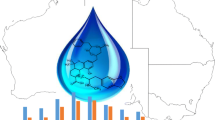Abstract
Consumption of illicit drugs is considered to be a global socioeconomic burden of adverse ecological and public health. Proper identification and quantification of trace level residues of illicit drugs in wastewater allow for an estimation of drug usage in a community, the amount of drug discharge into the environment, and the overall fate of drugs in the environment. This chapter provides a procedural detail of the determination of select illicit drugs and their metabolites in wastewater, suspended particulate matter, and sewage sludge using high-performance liquid chromatography-electrospray ionization-tandem mass spectrometry.
Access this chapter
Tax calculation will be finalised at checkout
Purchases are for personal use only
Similar content being viewed by others
References
CARA (Comprehensive Addiction and Recovery Act) (2016) https://www.congress.gov/bill/114th-congress/senate-bill/524/text. Accessed on 22 March 2017
Subedi B, Loganathan B (2016) Environmental emission of pharmaceuticals from wastewater treatment plants in the U.S.A. In Persistent organic Chemicals in the Environment: status and trends in the Pacific Basin Countries II temporal trends, ACS symposium series. American Chemical Society, Washington, DC, pp 181–202
Daughton CG, Ternes TA (1999) Pharmaceuticals and personal care products in the environment: agents of subtle change? Environ Health Perspect 107:907–938
Subedi B, Kannan K (2014) Mass loading and removal of select illicit drugs in two wastewater treatment plants in New York State and estimation of illicit drug usage in communities through wastewater analysis. Environ Sci Technol 48:6661–6670
Baker DR, Kasprzyk-Hordern B (2011) Multi-residue analysis of drugs of abuse in wastewater and surface water by solid-phase extraction and liquid chromatography-positive electrospray ionization tandem mass spectrometry. J Chromatogr A 1218:1620–1631
Chiaia AC, Banta-Green C, Field J (2008) Eliminating solid phase extraction with large-volume injection LC/MS/MS: analysis of illicit and legal drugs and human urine indicators in U.S. wastewaters. Environ Sci Technol 42:8841–8848
Zuccato E, Chiabrando C, Castiglioni S, Calamari D, Bagnati R, Schiarea S, Fanelli R (2005) Cocaine in surface waters: a new evidence-based tool to monitor community drug abuse. Environ Health 4:14
Postigo C, Alda ML, Barcelo D (2008) Analysis of drugs of abuse and their human metabolites in waterbyLC-MS2: a non-intrusive tool for drug abuse estimation at the community level. Trends Anal Chem 27:1053–1069
Author information
Authors and Affiliations
Corresponding author
Editor information
Editors and Affiliations
Rights and permissions
Copyright information
© 2018 Springer Science+Business Media, LLC, part of Springer Nature
About this protocol
Cite this protocol
Foppe, K.S., Subedi, B. (2018). Analysis of Illicit Drugs in Wastewater Using High-Performance Liquid Chromatography-Electrospray Ionization-Tandem Mass Spectrometry (HPLC-ESI-MS/MS). In: Musah, R. (eds) Analysis of Drugs of Abuse. Methods in Molecular Biology, vol 1810. Humana Press, New York, NY. https://doi.org/10.1007/978-1-4939-8579-1_16
Download citation
DOI: https://doi.org/10.1007/978-1-4939-8579-1_16
Published:
Publisher Name: Humana Press, New York, NY
Print ISBN: 978-1-4939-8578-4
Online ISBN: 978-1-4939-8579-1
eBook Packages: Springer Protocols




